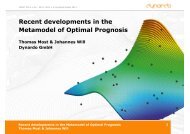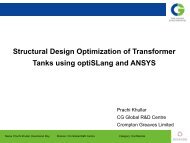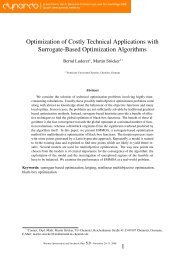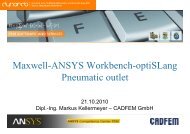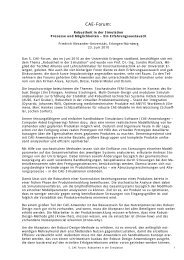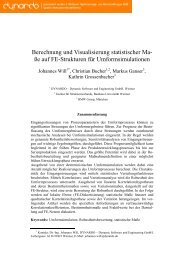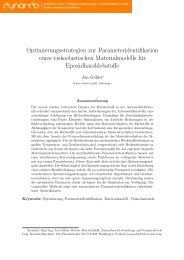Evolutionary Strategies for Multidisciplinary ... - Dynardo GmbH
Evolutionary Strategies for Multidisciplinary ... - Dynardo GmbH
Evolutionary Strategies for Multidisciplinary ... - Dynardo GmbH
Create successful ePaper yourself
Turn your PDF publications into a flip-book with our unique Google optimized e-Paper software.
<strong>Evolutionary</strong> <strong>Strategies</strong><br />
<strong>for</strong><br />
<strong>Multidisciplinary</strong> Optimization<br />
Prof. Dr. Thomas Bäck<br />
Managing Director, NuTech Solutions <strong>GmbH</strong><br />
CTO, NuTech Solutions, Inc.<br />
1
Overview<br />
Introduction: Optimization and EAs<br />
<strong>Evolutionary</strong> <strong>Strategies</strong><br />
Application Examples<br />
2
Background I<br />
Biology = Engineering (Daniel Dennett)<br />
3
Introduction:<br />
Optimization<br />
<strong>Evolutionary</strong> Algorithms<br />
4
Optimization<br />
f : objective function<br />
High-dimensional<br />
Non-linear, multimodal<br />
Discontinuous, noisy, dynamic<br />
M ⊆ M 1 × M 2 ×...× M n heterogeneous<br />
Restrictions possible over<br />
Good local, robust optimum desired<br />
Realistic landscapes are like that! Global Minimum<br />
Local, robust<br />
optimum<br />
5
Optimization Creating Innovation<br />
Illustrative Example: Optimize Efficiency<br />
Initial:<br />
Evolution:<br />
32% Improvement in Efficiency !<br />
6
Dynamic Optimization<br />
Dynamic Function<br />
30-dimensional<br />
3D-Projection<br />
7
Iterative Optimization Methods<br />
General<br />
description:<br />
x3<br />
xt v<br />
xt v<br />
s<br />
+ 1<br />
v<br />
t ⋅vt<br />
x2<br />
x1<br />
New Point<br />
Actual Point<br />
Directional vector<br />
Step size (scalar)<br />
At every Iteration:<br />
Choose direction<br />
Determine step size<br />
Direction:<br />
Gradient<br />
Random<br />
Step size:<br />
1-dim. optimization<br />
Random<br />
Self-adaptive<br />
8
The Fundamental Challenge<br />
Global convergence with probability one:<br />
v*<br />
lim Pr( x ∈ P(<br />
t))<br />
= 1<br />
t→∞<br />
General, but <strong>for</strong> practical purposes useless<br />
Convergence velocity:<br />
ϕ =<br />
E( fmax<br />
( P(<br />
t + 1))<br />
− fmax<br />
( P(<br />
t)))<br />
Local analysis only, specific (convex) functions<br />
9
An Infinite Number of Pathological<br />
Cases !<br />
f(x1 ,x2 )<br />
NFL-Theorem:<br />
x 2<br />
f(x* 1 ,x* 2 )<br />
(x* 1 ,x* 2 )<br />
All optimization algorithms per<strong>for</strong>m equally well iff<br />
per<strong>for</strong>mance is averaged over all possible<br />
optimization problems.<br />
Fortunately: We are not Interested in „all possible<br />
problems“<br />
x 1<br />
10
Evolution <strong>Strategies</strong><br />
11
Generalized <strong>Evolutionary</strong> Algorithm<br />
t := 0;<br />
initialize(P(t));<br />
evaluate(P(t));<br />
while not terminate do<br />
od<br />
P‘(t) := mating_selection(P(t));<br />
P‘‘(t) := variation(P‘(t));<br />
evaluate(P‘‘(t));<br />
P(t+1) := environmental_selection(P‘‘(t) ∪ Q);<br />
t := t+1;<br />
12
Evolution Strategy – Basics<br />
Mostly real-valued search space IR n<br />
also mixed-integer, discrete spaces<br />
Emphasis on mutation<br />
n-dimensional normal distribution<br />
expectation zero<br />
Different recombination operators<br />
Deterministic selection<br />
(μ, λ)-selection: Deterioration possible<br />
(μ+λ)-selection: Only accepts improvements<br />
λ >> μ, i.e.: Creation of offspring surplus<br />
Self-adaptation of strategy parameters.<br />
13
Representation of search points<br />
Self-adaptive ES with single step size:<br />
One σ controls mutation <strong>for</strong> all xi Mutation: N(0, σ)<br />
v<br />
a = ,..., ), σ )<br />
(( x1<br />
xn<br />
14
Evolution Strategy:<br />
Algorithms<br />
Mutation<br />
15
Operators: Mutation – one σ<br />
Self-adaptive ES with one step size:<br />
One σ controls mutation <strong>for</strong> all x i<br />
Mutation: N(0, σ)<br />
Individual be<strong>for</strong>e mutation<br />
v<br />
a = (( x1,...,<br />
xn<br />
), σ )<br />
v<br />
a′<br />
= (( x′<br />
,..., x′<br />
), σ ′ )<br />
i<br />
x<br />
i<br />
1<br />
σ ′ = σ ⋅exp(<br />
τ ⋅ N<br />
x′<br />
=<br />
n<br />
0<br />
+ σ ′ ⋅ N<br />
i<br />
( 0,<br />
1)<br />
( 0,<br />
1))<br />
Individual after mutation<br />
1.: Mutation of step sizes<br />
2.: Mutation of objective variables<br />
Here the new σ‘ is used!<br />
16
Operators: Mutation – one σ<br />
Thereby τ 0 is the so-called learning rate<br />
Affects the speed of the σ-Adaptation<br />
τ 0 bigger: faster but more imprecise<br />
τ 0 smaller: slower but more precise<br />
How to choose τ 0 ?<br />
According to recommendation of Schwefel*:<br />
τ 0 =<br />
*H.-P. Schwefel: Evolution and Optimum Seeking, Wiley, NY, 1995.<br />
1<br />
n<br />
17
Operators: Mutation – one σ<br />
Position of parents (here: 5)<br />
Contour lines of<br />
objective function<br />
Offspring of parent lies on<br />
the hyper sphere (<strong>for</strong> n > 10);<br />
Position is uni<strong>for</strong>mly distributed<br />
18
Evolution Strategy<br />
Algorithms<br />
Selection<br />
19
Operators: Selection<br />
Example: (2,3)-Selection<br />
Example: (2+3)-Selection<br />
Parents don‘t survive …<br />
Parents don‘t survive!<br />
… but a worse offspring.<br />
… now this offspring survives.<br />
20
Operators: Selection<br />
Possible occurrences of selection<br />
Exception!<br />
(1+1)-ES: One parent, one offspring, 1/5-Rule<br />
(1,λ)-ES: One Parent, λ offspring<br />
Example: (1,10)-Strategy<br />
One step size / n self-adaptive step sizes<br />
Mutative step size control<br />
Derandomized strategy<br />
(μ,λ)-ES: μ > 1 parents, λ > μ offspring<br />
Example: (2,15)-Strategy<br />
Includes recombination<br />
Can overcome local optima<br />
(μ+λ)-strategies: elitist strategies<br />
21
Evolution Strategy: Strategy<br />
Self adaptation of<br />
step sizes<br />
22
Self-adaptation<br />
Self adaptation<br />
No deterministic step size control!<br />
Rather: Evolution of step sizes<br />
Biology: Repair enzymes, mutator-genes<br />
Why should this work at all?<br />
Indirect coupling: step sizes – progress<br />
Good step sizes improve individuals<br />
Bad ones make them worse<br />
This yields an indirect step size selection<br />
23
Self-adaptation<br />
Self adaptation: : Example<br />
How can we test this at all?<br />
Need to know optimal step size …<br />
Only <strong>for</strong> very simple, convex objective functions<br />
*<br />
Here: Sphere model<br />
x : Optimum<br />
v<br />
Dynamic sphere model<br />
n<br />
v<br />
f ( x)<br />
( xi<br />
− xi<br />
= ∑<br />
i=<br />
1<br />
Optimum locations changes occasionally<br />
*<br />
)<br />
2<br />
24
Self-adaptation<br />
Self adaptation: : Example<br />
Example Objective function value<br />
According to theory<br />
ff optimal step sizes<br />
Largest …<br />
average …<br />
… and smallest step size<br />
measured in the population<br />
25
Self-adaptation<br />
Self adaptation<br />
Self-adaptation of one step size<br />
Perfect adaptation<br />
Learning time <strong>for</strong> back adaptation proportional n<br />
Proofs only <strong>for</strong> convex functions<br />
Individual step sizes<br />
Experiments by Schwefel<br />
Correlated mutations<br />
Adaptation much slower<br />
26
Mixed-Integer<br />
Mixed Integer<br />
Evolution <strong>Strategies</strong><br />
27
Mixed-Integer Mixed Integer Evolution Strategy<br />
Generalized optimization problem:<br />
28
Mixed-Integer Mixed Integer ES: Mutation<br />
Learning rates<br />
(global)<br />
Learning rates<br />
(global)<br />
Geometrical<br />
distribution<br />
Mutation<br />
Probabilities<br />
29
Literature<br />
H.-P. Schwefel: Evolution and Optimum Seeking, Wiley, NY,<br />
1995.<br />
I. Rechenberg: Evolutionsstrategie 94, frommann-holzboog,<br />
Stuttgart, 1994.<br />
Th. Bäck: <strong>Evolutionary</strong> Algorithms in Theory and Practice,<br />
Ox<strong>for</strong>d University Press, NY, 1996.<br />
Th. Bäck, D.B. Fogel, Z. Michalewicz (Hrsg.): Handbook of<br />
<strong>Evolutionary</strong> Computation, Vols. 1,2, Institute of Physics<br />
Publishing, 2000.<br />
30
<strong>Multidisciplinary</strong> Optimization (MDO)<br />
rear impact<br />
high speed<br />
rear impact<br />
low speed<br />
Lateral impact<br />
Statics<br />
MDO<br />
Dynamic<br />
front impact<br />
high speed<br />
Front impact<br />
low speed<br />
Different disciplines involved (crash cases, NVH, statics, …).<br />
Very demanding simulation (multiple CPUs, many hours).<br />
Large number of parameters and constraints.<br />
Very few evaluations (shots) possible (often < 300).<br />
31
Example 1<br />
Courtesy of<br />
32
MDO Crash / Statics / Dynamics<br />
Minimization of body mass<br />
Finite element mesh<br />
Crash ~ 130.000 elements<br />
NVH ~ 90.000 elements<br />
Independent parameters:<br />
Thickness of each unit: 109<br />
Constraints: 18<br />
Algorithm<br />
Best so far<br />
NuTech ES<br />
Avg. reduction (kg)<br />
-6.6<br />
-9.0<br />
Max. reduction (kg)<br />
-8.3<br />
-13.4<br />
Min. reduction (kg)<br />
-3.3<br />
-6.3<br />
33
MDO Production Runs (I)<br />
Minimization of body mass<br />
Finite element mesh<br />
Crash ~ 1.000.000 elements<br />
NVH ~ 300.000 elements<br />
Independent parameters:<br />
Thickness of each unit: 136<br />
Constraints: 47, resulting from various load cases<br />
180 (10 x 18) shots ~ 12 days<br />
rear impact<br />
high speed<br />
rear impact<br />
low speed<br />
Lateral impact<br />
Statics<br />
MDO<br />
Dynamic<br />
No statistical evaluation due to problem complexity<br />
front impact<br />
high speed<br />
Front impact<br />
low speed<br />
34
MDO Production Runs (II)<br />
Mass<br />
NuTech’s Evolution Strategy<br />
Generations<br />
Initial Value<br />
13,5 kg weight reduction by NuTech’s ES.<br />
Beats best so far method significantly.<br />
Typically faster convergence velocity of ES.<br />
Reduction of development time from 5 to 2 weeks allows <strong>for</strong><br />
process integration.<br />
Still potential <strong>for</strong> further improvement after 180 shots.<br />
35
Example 2<br />
Courtesy of<br />
36
MDO ASF ® Front Optimization<br />
Pre-optimized Space-Frame-Concept – improvement possible?<br />
Goal: Minimization of structural weight<br />
Degrees of freedom:<br />
Wall thicknesses of the semi-finished products sheet & profile<br />
Material characteristic profile<br />
Limitation of design space:<br />
Semi-finished products technology<br />
Technique <strong>for</strong> joining parts<br />
37
MDO ASF ® Disciplines<br />
Damage according<br />
to insurance classification,<br />
Component Model,<br />
2 CPUs<br />
Global dynamic stiffness,<br />
Trimmed Body,<br />
1 CPU<br />
Front Crash (EURO NCAP),<br />
Complete Body<br />
4 CPUs<br />
Resources per Design: 7 CPUs, approx. 23h<br />
38
MDO Run Comparison<br />
Initial design, constraints violated<br />
Masse Mass<br />
Mass<br />
Best so far optimizer<br />
Optimum (exp. 924),<br />
Constraints satisfied<br />
Increased<br />
weight!<br />
Optimum (exp. 376),<br />
Constraints satisfied<br />
Decreased<br />
weight!<br />
39
Concluding Remarks<br />
ES are very useful <strong>for</strong> MDO tasks<br />
High dimensionality<br />
Few evaluations (shots) possible<br />
Mixed-integer tasks<br />
MCDM tasks<br />
40
Corporate Headquarters:<br />
Charlotte, NC<br />
121 West Trade Street<br />
Interstate Tower, Suite 1900<br />
Charlotte, NC 28202<br />
Phone: (704) 943-5400<br />
Fax: (704) 943-5401<br />
Thank You!<br />
Dortmund, Germany<br />
Martin-Schmeisser-Weg 15<br />
44227 Dortmund<br />
Germany<br />
Phone: +49-231-725-4630<br />
Warsaw, Poland<br />
Łucka 11, lok.508<br />
00-842 Warszawa<br />
Poland<br />
Phone: (+4822) 656-33-99<br />
Fax: (+4822) 656-31-21<br />
41



